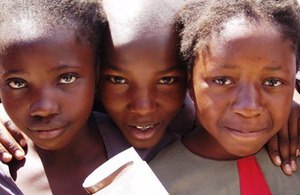MDG 2 - Universal primary education in Zambia
The Government of Zambia has established access and quality of education, especially for girls, as a national priority, even in hard economic times.

Zambia: Young girls From Chawama Basic School. Picture: USAID
The Government of Zambia has established access and quality of education, especially for girls, as a national priority, even in hard economic times. Efforts have ranged from far-reaching policy reform to expanded access to education.
Zambia is addressing poor access to education through MDG 2. In 2002, the Ministry of Education enacted the Free Basic Education policy, which has subsequently led Zambia to dedicate substantially more domestic resources to education. From 2006 to 2010, funding to the education sector steadily increased from 2.9% to 3.5% of GDP. Zambia improved school infrastructure, including water, and sanitation. Teacher training programs have increased the teacher supply to match the expansion of school enrollment. The number of teachers increased from 50,123 (27,559 males and 22,564 females) in 2002 to 77,362 (39,733 males and 37,629 females) in 2009.
Student enrolment has increased from 2.5 million students in 2005 to 3.3 million in 2009. Furthermore, the participation of girls increased from 1.4 million in 2005 to 1.65 million in 2009. The Gender Parity Index (GPI) improved from 0.95% to 0.99%.
Over one third of the girls who became pregnant returned to school between 2002 and 2009. Over 200,000 students in basic schools were reached with improved water and sanitation.
The policy offers diverse approaches to bring children to education. Women are particularly supported by the policy through bursaries or scholarships and by encouraging them to return to school after pregnancy. Radio campaigns are encouraging girls and children from low socio-economic status to go into schools.
The policy also created opportunities for communities to initiate and manage local schools for their children; the number of community schools grew from less than 200 in 1996 to over 3,000 in 2009. Monica Hangwinto is one happy 11-year-old because, since last year, she can attend school here in Shimballa village, just a 20-minute walk from home. Before the school was built in 2009, she could not get an education. The nearest classroom was a two hour walk away. Monica could not easily trek that far, and her parents were afraid something might happen to her on her way, as has been the case with other playmates who were harassed, assaulted, or killed in traffic accidents.
At the school in Shimbala, headmistress Margaret Mudenda is quietly satisfied. Today, like nearly every day, four new children have joined the school, and there are more and more of them. Her efforts have paid off: the community’s requests have been answered and the local kids can now finally learn. The community contributed more than 25% of the costs of the school through hard manual labor and also gave the land for the school and for the teachers’ plots.
Mrs. Mudenda is passionate about equal opportunities and enthused to see that more than half of the 185 pupils are girls. New children, including orphans, enroll every day, justifying her efforts. Nevertheless, challenges remain. The school is not fully finished: there is no glass yet in the windows, and it still lacks some furniture. The teachers’ houses are not quite ready, and they need more books. Even with double shifts, there are not enough teachers.
Key facts
The Ministry of Education in 2002 enacted the free basic education policy (Grades 1-7).
In 2007, the Ministry implemented the Every Child to School policy, which concentrated on infrastructure development and led to the building of 4,627 new classrooms. This initiative builds on the 1996 national education policy.
In 2008, the Education for All - Fast Track Initiative (EFA FTI) endorsed Zambia’s national education strategy. FTI was an important factor in the prioritisation of education in national policies, supporting the Zambian Government with a US$60 million allocation to the sector budget. Partnerships with non-governmental organizations and local communities have also been key.
Even at a time of economic difficulty, The Government of Zambia has maintained its focus on improving access, and investing in education. The focus now is moving to driving up quality standards.
More info: www.moe.gov.zm